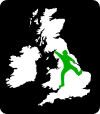
- The most recent issue to be published was 132
- For further information, please see Publishing/Despatch Schedule
- Database last updated on Mon, 01 Dec 2025 18:30:34 +0000
- Online access is currently available for all issues. Some of
the older issues are bit-map scans rather than digital copies.
journal scans.
- Online voting for CREG articles was withdrawn in June 2022. For info see
Voting for CREG articles
Contents of journal 59
March 2005
This page may take a few
seconds to load. Please wait ...
- CREG Journal
(PDF 7.4MB)
  Individual articles may be available below Individual articles may be available below
- Contents
-
- Newssheet
- A New Editor, CREG Autumn Field Meeting, Equipment Loan, Printed Circuit Boards, Email Addresses, Diary Dates, International Speleo Congress, Committee Changes.
-
- A Portable Double-Sideband Cave Radio
- John Hey describes his 'handiphone', a double-sideband cave radio that is intended to be compatible with the single-sideband HeyPhone. It does not offer ideal demodulation of the incoming SSB signals and some power is wasted by transmitting an unwanted sideband but, conversely, the DSB circuitry is simpler and allows the construction of a portable, hand-held device.
-
- Double-Sideband v. Single-Sideband
- David Gibson explains the pros and cons of inter-operating DSB and SSB radios.
-
- Satellite Phones: A Beginner's Guide
- Despite the almost universal coverage of mobile phone networks in many countries, service remains sparse in rural areas of the developing world. Yet these are exactly the sorts of areas that often attract caving expeditions. Satellite networks fill these gaps providing, in some cases, coverage of the entire planet. Mike Bedford looks at what's available.
-
- Earth Current Arrays - The Range of Impedance
- The impedance presented at the feed point by an earth current array depends very much on the geology and on the earth electrode configurations. Having analysed some field measurements, John Rabson discusses whether we should improve the matching arrangements between the antenna and the radio.
-
- Speleonics
- A question on atmospheric noise cancellation lead to a discussion of why the CCIR noise data was not applicable to 'cave radio' and a plea for measurements to be made of the magnetic noise field. Column edited by John Rabson.
-
- Lithium-Ion Batteries for Caving Projects
- Li-Ion battery technology has much to recommend it, so why don't cavers use it? Martin Melzer looks at cell protection and charging requirements and identifies a cost-effective solution.
-
- Web Watch
- Peter Ludwig brings us another wide-ranging selection of Web sites. Online access to the sites mentioned is available from a page kindly provided by Martin Melzer.
-
- Using FPGAs for Digital Filtering
- Digital filters are usually implemented in software, where the processor speed can limit the performance. Graham Naylor describes how field programmable gate arrays can improve the throughput of a filter algorithm by performing many multiply-accumulate cycles at the same time.
-
- Radio Devices for Remote Data Logging
- Mike Bedford investigates commercially available RF modules and radio modems that could be used to retrieve information from remote data logging sites.
-
- A Sonic Flow-Rate Meter for Measurements in Air and Water
- When sound waves are transported by a medium that is, itself, in motion, the speed of sound can be used to determine the flow rate of the medium. David Gibson describes this well-established technique, suggesting a practical implementation that can measure micro-climatic air conditions and water flow rate without any moving parts.
-
- Cave Radio Notebook
- 63: Alternative(?) HeyPhone Inductors, 64: The 3-Point Method for Measuring Earth Electrode Resistance, 65: Earth Potentials, 66: A Ferrite Antenna for the HeyPhone, 67: HeyPhone AGC, 68: Designing a Full-Duplex Single Wire Telephone. Edited by David Gibson.
-
- A Roofing Filter
- John Rabson describes a front-end bandpass filter used with a cave radio receiver to reduce adjacent channel interference.
-
- We Hear
- News from the world of cave radio and electronics. Carlsbad Cavern Recordings, Global Amateur Radio Emergency Communications Conference. Column edited by Rob Gill.
-
- Letters to the Editor
- Topics include Google Scholar, eBay, 'Nicking' and a Letter from the Editor.
-

|

View Contents:

BCRA is a UK registered charity and is a constituent body of
the British Caving Association,
undertaking charitable activities on behalf of the BCA.
BCRA publishes a range of periodicals and books.
Click here for further information.
|
Searching
To Search our pages using Google, type a search
string in the box at the top of the page and hit your Return key
You can also search our publications catalogue at the British Caving Library
The CREG Journal Search Engine is a new, powerful search engine which will, sometime, be extended
to cover Cave & Karst Science. We have a keyword search facility on our Cave Science Indexes pages but this may be rather out-of-date.
|
For staff use: Link to Database
Show/Hide
download figures next to each item (if available and non-zero; you might need to refresh page first). Counters last
reset on Thu 03-Jan-2019 17:29:28 +00:00. The figures are non-unique
click-throughs.
|









